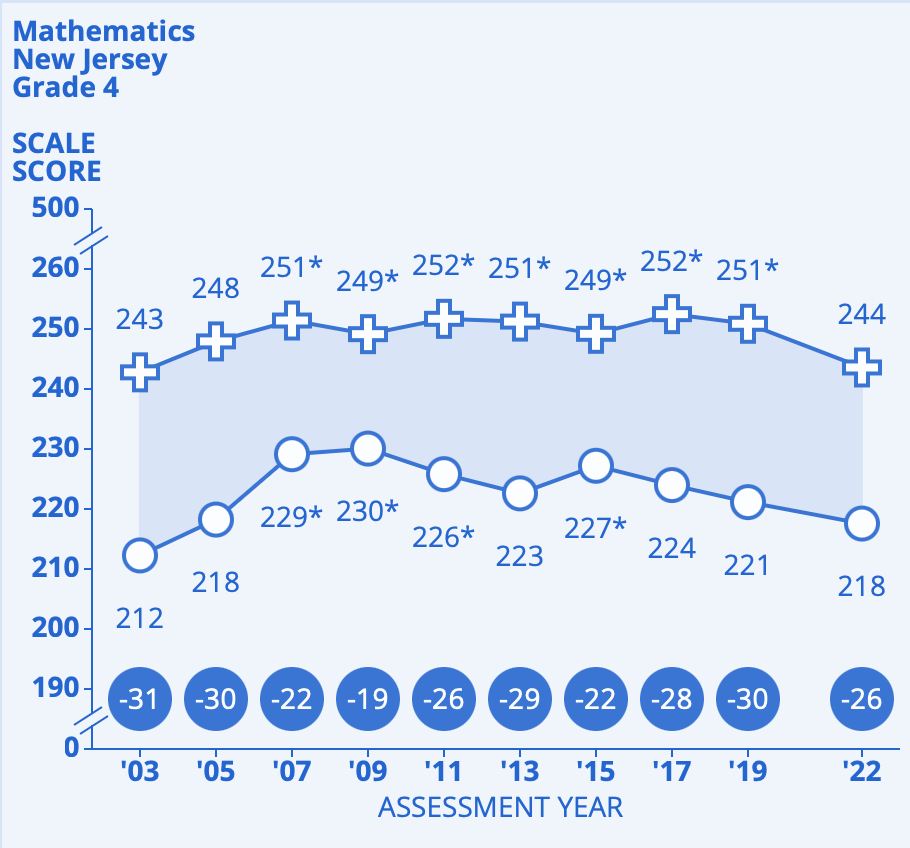Introduction
New Jersey is home to one of the largest populations of students with disabilities (SWDs) in the United States. Almost one-fifth of our public school students aged 3 to 21 (18%) are served under the Individuals with Disabilities Education Act (IDEA). School closures and virtual classrooms necessitated by the COVID-19 pandemic posed unique challenges for educators.
The achievement gap, which refers to the disparity in academic performance, between students with and without disabilities persists post-COVID-19 pandemic. Data provided by the National Assessment of Educational Progress show that a gap between these groups of students (i.e., those with and without disabilities) has been evident for the past decade in various subject areas. Figures 1 and 2 demonstrate a drop in overall academic performance in the first school year post-COVID-19, 2021-2022, for 4th-grade students in standardized assessments for mathematics and reading. This decline is pronounced among students with disabilities, who faced compounded challenges during the transition to distance learning.
Note: Students without disabilities are represented as a plus sign, while students with disabilities are represented as a circle.
Figure 1

Figure 2

What Happened During the Pandemic?
The pandemic exacerbated challenges for students with disabilities. Factors affecting special education include the digital divide and disparities in access to technology and broadband internet access. Some students may not have had access to the internet and/or necessary technologies that are typically found in the classroom, which could further exacerbate challenges with remote learning, particularly for students with disabilities (SWDs).
A loss of learning and retention can occur when a student’s education is impacted by gaps and inconsistencies in teaching. According to the National Center for Education Statistics, in June 2022, public schools reported that, on average, 50% of public school students were behind grade level in at least one academic subject area at the beginning of the 2021-22 school year, compared to 36% at the end of the school year.
Pandemic-Related Legislative Process to Address Students with Disabilities’ Learning Loss
In response to the challenges faced by one of the state’s most vulnerable student populations, New Jersey passed two bills aimed at addressing some gaps left by the pandemic.
Passed in June of 2021, this bill requires boards of education to provide special education and necessary services to students exceeding the age of eligibility for special education. This involves students who reached the maximum age of 21 during the school years of 2020-2021, 2021-2022, and 2022-2023. However, some students with disabilities who could have benefitted from these provisions had graduated. For other students, the decision for additional schooling is made between the student’s parents and their IEP team based on the student’s demonstrated need.
Passed in March of 2022, this bill extended the period in which families with students with disabilities can file for a due process petition regarding the identification, evaluation, or educational placement that would ensure the provision of free and appropriate public education (FAPE) during the COVID-19 school closure. A review of the 33 cases that petitioned for compensatory services found that 80% were denied. The law does not stipulate any requirement of the New Jersey Department of Education to collect data regarding school district compliance.
Conclusion
The pandemic brought awareness of the challenges faced by students with disabilities – and exacerbated some of them. Legislative efforts like S3434 and S905 were passed to address such challenges. Students with disabilities (SWDs) must receive a free and appropriate public education, which is especially critical as we continue to address their educational needs post-pandemic.
Jordyn Roy is an undergraduate student double majoring in Political Science and Public Policy at the School of Arts and Sciences and the Bloustein School of Planning and Public Policy at Rutgers University. Jordyn was also one of eight students selected to participate in the New Jersey State Policy Lab’s third annual Summer Internship program.
